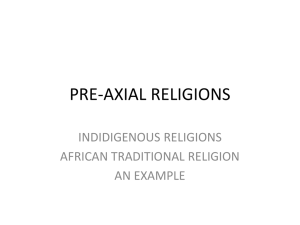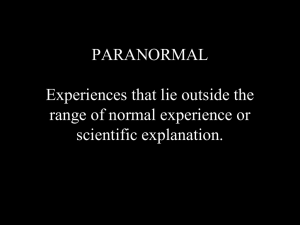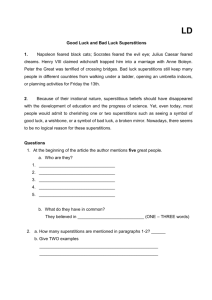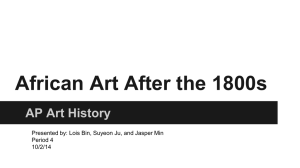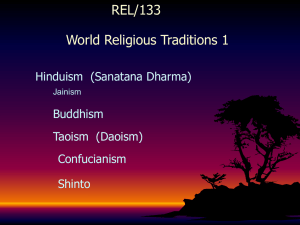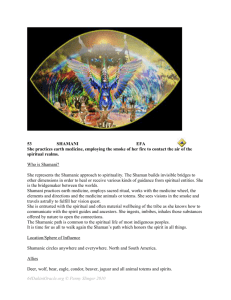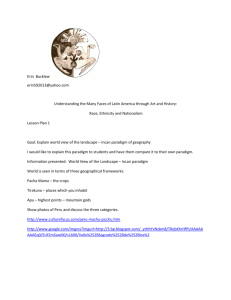Umbanda: An Afro-Brazilian Religion
advertisement
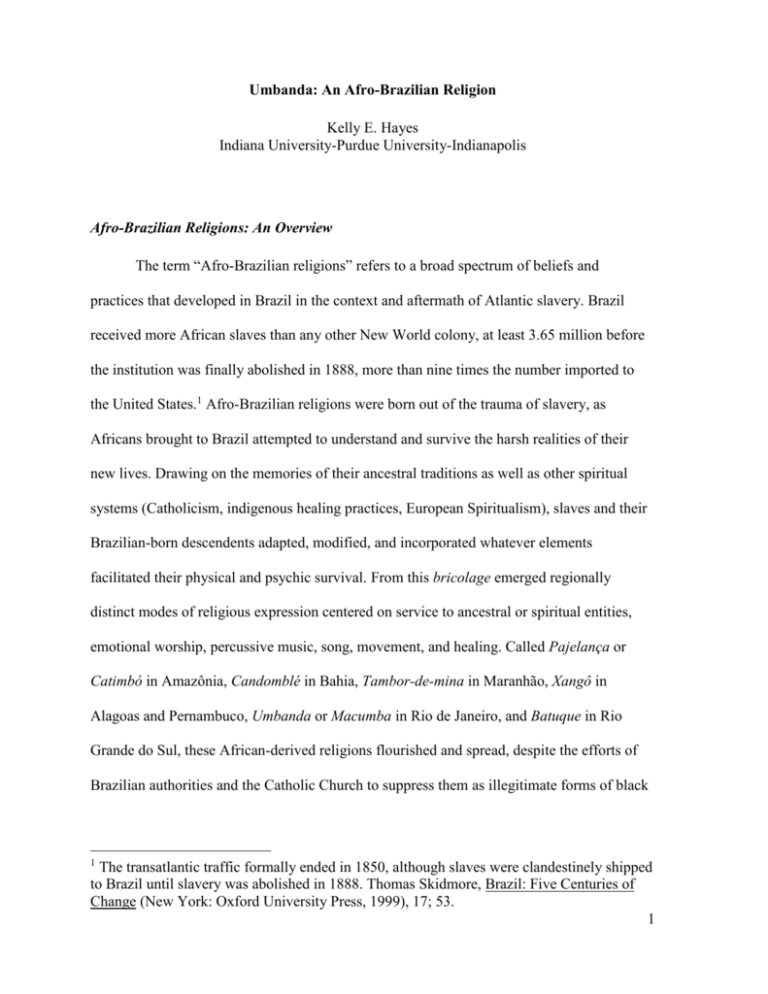
Umbanda: An Afro-Brazilian Religion Kelly E. Hayes Indiana University-Purdue University-Indianapolis Afro-Brazilian Religions: An Overview The term “Afro-Brazilian religions” refers to a broad spectrum of beliefs and practices that developed in Brazil in the context and aftermath of Atlantic slavery. Brazil received more African slaves than any other New World colony, at least 3.65 million before the institution was finally abolished in 1888, more than nine times the number imported to the United States.1 Afro-Brazilian religions were born out of the trauma of slavery, as Africans brought to Brazil attempted to understand and survive the harsh realities of their new lives. Drawing on the memories of their ancestral traditions as well as other spiritual systems (Catholicism, indigenous healing practices, European Spiritualism), slaves and their Brazilian-born descendents adapted, modified, and incorporated whatever elements facilitated their physical and psychic survival. From this bricolage emerged regionally distinct modes of religious expression centered on service to ancestral or spiritual entities, emotional worship, percussive music, song, movement, and healing. Called Pajelança or Catimbó in Amazônia, Candomblé in Bahia, Tambor-de-mina in Maranhão, Xangô in Alagoas and Pernambuco, Umbanda or Macumba in Rio de Janeiro, and Batuque in Rio Grande do Sul, these African-derived religions flourished and spread, despite the efforts of Brazilian authorities and the Catholic Church to suppress them as illegitimate forms of black 1 The transatlantic traffic formally ended in 1850, although slaves were clandestinely shipped to Brazil until slavery was abolished in 1888. Thomas Skidmore, Brazil: Five Centuries of Change (New York: Oxford University Press, 1999), 17; 53. 1 magic. Today they attract Brazilians from across the socioeconomic spectrum, although poor and working class followers tend to predominate. One of the most distinctive characteristics of Afro-Brazilian religions is their eclecticism. These are religions that resist systematization, either by scholars or census takers. Like Vodou, Santería and other traditions that developed in the slave societies of the New World, Afro-Brazilian religions are organized around independent “houses” or communities, each with its own heritage and pantheon of supernatural powers. There is no universally recognized institution that determines doctrine, trains clerics, or enforces standards of ritual practice. Neither is there a formal creed or standardized set of beliefs that must be espoused by participants. This makes it difficult to point to a certain set of beliefs or rituals as defining criteria. Nevertheless, Afro-Brazilian religions do share a religious sensibility, or orientation to the universe, derived from their West and Central African roots: a) the notion that the human and spiritual worlds are mutually interdependent and in constant interaction; b) the importance of the human body as a privileged means through which the spiritual world is made manifest; c) the special role of rhythm, movement, music, song, dance, material offerings and objects; d) an emphasis on healing and the resolution of pragmatic problems; e) the use of diverse therapeutic techniques for purification and spiritual protection, including herbal treatments, offerings, prayers, censing with smoke, incantations, amulets, and so forth; f) the importance of oral tradition and ritual, rather than sacred text, as the mode of transmitting religious knowledge. 2 At the heart of all Afro-Brazilian religions is a concern with alleviating suffering and realizing wellbeing by fortifying the links between the human and the spiritual worlds. While practitioners recognize the Christian God, they believe that this God interacts with human beings through spiritual intermediaries. Afro-Brazilian religions recognize a variety of such supernatural beings, including Catholic saints (santos), African deities associated with natural phenomena and familial lineages (orixás or voduns), ancestral figures (inquices), archetypal folk characters such as the spirits of elderly black slaves (pretos velhos), indigenous Indians (caboclos), and street smart tricksters (exus and pomba giras), as well as the spirits of the deceased (eguns). Through an elaborate body of myths, rituals, songs, symbols, offerings, movements, and gestures, participants seek to understand and organize their lives in relationship to these supernatural entities. There is no developed notion of sin or a need for salvation. In the Afro-Brazilian worldview, human beings are embedded within complex webs of rights and responsibilities that situate them in relation to the natural world of family, community, and the environment, and to the supernatural world of spiritual beings. Wellbeing is the product of a dynamic state of equilibrium between these worlds and results when ties of commitment and reciprocity are acknowledged through ritual means, facilitating the continuous flow of spiritual energy through the universe. This concept of dynamic equilibrium through ritual work is expressed in the notion of service, a central value in AfroBrazilian religions. Through their offerings, ceremonies, feasts, and other devotional activities, practitioners “serve” the spirits, enjoying in return the active presence of the spirits in their lives. When properly served, spirits offer guidance, protection, and practical assistance to their human devotees. When neglected, they can provoke persistent physiological, psychological, economic, or personal problems including bad luck, adversity 3 and interpersonal difficulties, as well as chronic illnesses such as headache, fatigue, loss of appetite, dizziness, and blackouts. Most participants join Afro-Brazilian religious groups in search of a resolution for these types of problems. Healing involves addressing the physiological, emotional, social and, most importantly, the spiritual dimensions of the individual’s particular affliction. For example, an individual suffering from persistent headaches may be treated with a mix of herbal remedies, talk therapy, and highly symbolic ritual processes designed to externalize the problem, fortify the individual’s relationship with their patron spirits, and incorporate them into the larger religious community. Within the framework of Afro-Brazilian religions, the root cause of most human suffering lies in an imbalance in the individual’s relationship to the spirit world and may be resolved by strengthening her or his relationship with that world. This is not to say that Afro-Brazilian healers ignore the physiological causes of illness, but that they understand human wellbeing as encompassing body, mind, and spirit. Sometimes an individual’s problem is determined to be a spirit who is demanding recognition by causing blackouts or other types of behavioral disturbances. In these cases, healing involves a protracted process of training under the guidance of a religious specialist in which the afflicted learns how to serve the spirit by ritually receiving it in possession trance. When regularly incorporated in the context of ceremonial rituals, spirits are believed to cease their disruptions and to actively assist followers in achieving their goals. Perhaps the most dramatic example of the intimate relationship between the human and supernatural worlds, spirit possession is a central feature of all Afro-Brazilian religions. In this form of embodied spirituality, supernatural beings are made present within the human community in the bodies of their devotees, who claim to remember little or nothing of the experience. Although not all are capable of serving the spirits in this way, those who do are 4 highly valued within Afro-Brazilian religious groups as direct channels to the supernatural world. Because of its spectacular aspects, spirit possession has received a great deal of attention from scholars and outsiders. For followers, however, it is an ordinary feature of religious life, one of many forms of service to the spirits. Spirit possession generally occurs in special ceremonies held on regular occasions. Ritually summoned from their otherworldly abode through rhythm, music, song, and dance, the spirits are invited to “mount” their devotees. Once incorporated, the spirits dance, sing, or confer with the faithful who have assembled to receive them, blessing the community with their presence. The atmosphere on these occasions is one of festive celebration, and ceremonies typically attract large audiences of on-lookers who come for entertainment or to petition a particular spirit entity for help in resolving a problem. Umbanda The Afro-Brazilian religion Umbanda embraces an eclectic repertoire of spirit entities drawn from various traditions. Because of its synthesis of African, European, and Amerindian elements, the legendary three races that coalesced to form the Brazilian people, practitioners sometimes characterize Umbanda as the country’s first truly original religion. Like all Afro-Brazilian religions, Umbanda is a diverse movement composed of independent ritual communities, each with its own devotional life, pantheon of spirit entities, and organizational structure. What unites these communities is a concern with addressing the spiritual dimensions of human affliction through the practice of mediumship, and a shared understanding of the universe derived from the theories of the 19th century French philosopher Allen Kardec. 5 Although they had little influence in his native land, Kardec’s theories found a receptive audience among educated Brazilian elites. Based on his “scientific” analysis of paranormal phenomena, Kardec claimed that he had derived the principles of a new philosophy he called Spiritism. Central to Spiritism was the claim that after death the human soul lived on in disembodied, spirit form before being reincarnated on earth in either a more evolved or less evolved human form. By performing good deeds and studying Kardecist doctrine, a human soul could evolve along a spiritual hierarchy, eventually becoming a “spirit of light,” or guide (guia), no longer subject to reincarnation. Through a trained medium, these evolved spirit guides transmitted moral instruction and spiritual healing to those in need. Conversely, negative or immoral conduct resulted in regression to a lower level on the spirit hierarchy, and eventual rebirth in a less-evolved human form. Lower-level “spirits of the shadows” could attach themselves to people and provoke problems such as alcoholism, drug abuse, accidents, and other misfortunes. Mediums were those individuals specially trained to communicate with spirits and to diagnose and treat spirit ailments. From Spiritism, Umbanda inherited the notion of a hierarchical universe made up of a series of spirit entities arrayed on an evolutionary continuum. These range from the most developed entities who rarely descend to the terrestrial realm: Jesus Christ, the spirits of great European philosophers, and the African orixás; through a series of lesser-developed entities: the spirits of African slaves (pretos velhos) and indigenous Indians (caboclos); and finally the least-developed entities: the spirits of children (erês), street savvy hustlers (exus), prostitutes (pomba giras), and the dead (eguns). Some Umbanda centers recognize in addition the spirits of gypsies (ciganas), sailors (marinheiros), cowboys (boiadeiros), and other marginal social types. 6 Practitioners often describe these lesser-developed “spirits of the shadows” as lacking “light” (sem luz), a characteristic that results from their more primitive rank on the evolutionary continuum. Within Umbanda, a spirit may evolve and eventually reach the upper echelons through the performance of charity (cariedade), occasioned by the help they render to humans who come to consult them in Umbanda rituals (toques). This process sometimes is referred to as “indoctrination” or “baptism.” Through an intermediary (médium), who either incarnates them or translates their messages, indoctrinated spirits are thought to work on behalf of their human supplicants, recipients of the charity that will lead to the spirit’s own evolution. While Umbanda practitioners may acknowledge the orixás with offerings of food, drink, flowers, and candles, most focus their ritual attention on lower-level spirits, particularly caboclos, pretos velhos, exus and pomba giras, who because of their own difficult experiences while on earth are thought to understand the sufferings of their human devotees and to possess the spiritual resources to help them. Incorporated in the body of a medium, these spirits return to earth to “consult” with petitioners and to execute a variety of spiritual cures. Both men and women serve as mediums in Umbanda, although women tend to outnumber men. While some attribute this to women’s greater sensitivity, there is little developed sense that innate female traits predispose women to serve the spirits, as is sometimes asserted in Candomblé. Rather all humans are believed to possess the ability to become mediums and to work for the spiritual evolution of all beings. Historical Overview Historians concur that Umbanda emerged sometime in the first three decades of the twentieth century in the southeastern cities of Rio de Janeiro and Porto Alegre. Although 7 there is probably no one original center from which Umbanda sprang, scholars and practitioners often invoke the story of Zélio de Moraes. Like most origin narratives, Zélio’s is replete with highly symbolic and mythological aspects, and exists in various versions. Nevertheless, it indicates some of the formative issues in the development of Umbanda. While attending a service at a Spiritist center in Rio de Janeiro sometime in the 1920s, Zélio de Moraes witnessed mediums being possessed by the spirits of black slaves (pretos velhos) and Indians (caboclos). Within Kardec’s hierarchical framework these spirits were considered unevolved due to the cultural level of their previous lives, and were promptly dispatched. Zélio then felt himself taken over by one of these entities, who announced that he would begin his own religion dedicated to the humble spirits of Brazil’s black slaves and original inhabitants. In the mid-1920s, Zélio founded the Spiritist Center of Our Lady of Piety on the outskirts of the city of Rio de Janeiro and dedicated it to the caboclo spirit that had first possessed him.2 Whether or not this represents the “true” historical origins of Umbanda, Zélio’s story suggests the centrality of class and race in the formation of Umbanda and in its relationship with Spiritism, which was practiced mostly by middle and upper class whites. With its pantheon of caboclos, pretos velhos, and other marginalized social types, Umbanda presents a populist vision of Brazilian social life. At the same time, the tension between this vision and the dominant elite’s antipathy towards their nation’s African and indigenous heritage runs throughout the history of Umbanda. So while Umbanda in many ways represents a synthesis of Kardecist principles and popular Afro-Brazilian practices, from early on prominent practitioners were concerned to distance Umbanda from the “black barbarism” of Brazil’s African-derived traditions 2 Diana Brown, Umbanda: Religion and Politics in Urban Brazil (New York: Columbia University Press, 1994). 8 In 1941, Zélio and his male associates, nearly all of whom were white and middle class, organized the first Umbanda conference in order to define a uniform code of doctrine and practice, and to establish the religion as a distinctive movement separate from Kardecist Spiritism on the one hand and Afro-Brazilian religions on the other. According to Umbanda scholar Diana Brown, the proceedings of the conference indicated the founders’ concern to “purify” Umbanda by purging from it any associations with black Africa, claiming instead the religion’s mystical origins in either time immemorial or an ancient civilization (usually Egypt or India). Conference organizers repeatedly compared Umbanda with Macumba (the popular name for Afro-Brazilian traditions in the southeast), which they disparaged as black magic. In contrast to Macumba’s practice of animal sacrifice and drumming, and its leaders’ (alleged) exploitation of their simple-minded followers, they claimed that Umbanda was dedicated solely to the cultivation of benevolent spirits and the charitable provision of spiritual healing to those in need.3 The prominence of exu and pomba gira spirits in Macumba seems to have been a focus of special ire among conference goers. Lacking the light necessary for good deeds, these “spirits of the left” were to be exorcised, not revered. One of the main differences between Umbanda and Macumba, according to conference organizers, was the role of these dangerous spirits. Thus began a long process of bureaucratization, rationalization, doctrinal formation, and moralization in which predominately male, middle class Umbanda practitioners worked to systematize Umbanda beliefs and practices through various federations, conferences, and publications, as well as radio and television programs. At the same time, rank and file practitioners on the margins of these efforts embraced the African elements of their religion and welcomed exu and pomba gira spirits into their midst. As one argued “an Umbanda 3 Brown, Umbanda, 41-46. 9 terreiro which does not use drums or other ritual instruments, which does not sing [ritual hymns] in the African style, which does not offer sacrifices or food to the deities can be anything, but it is not a terreiro of Umbanda.”4 However, because they lacked the means to disseminate their perspectives more widely, alternative voices like this one remained peripheral within the institutionalization of Umbanda. Thanks largely to the sustained efforts of Umbanda’s codifiers, in the 1960s the religion was officially recognized in the national census and Umbanda festivals began to be included on official calendars. By the 1970s, Umbanda was the fastest growing religion in Brazil with an estimated twenty million followers nationwide. Today the religion has expanded beyond the nation’s borders and Umbanda centers can be found in Argentina and Uruguay. As is the case for most “official” versions of history, men have dominated the history of Umbanda, at least as it has been preserved in the records of the religion’s more institutionalized forms. In practice however, women participate in equal or greater numbers than men. As mediums, they embody humble black slaves and proud Indian warriors, hustlers and prostitutes—archetypal folk characters whose stories are largely absent from the dominant narrative of Brazilian history. As leaders of the small and usually ephemeral centers that serve the vast majority of Umbanda’s followers, women attend to the physical and spiritual needs of their communities. For many of these women, Umbanda’s emphasis on healing and the authority of spirit guides permits them to exercise a form of power otherwise denied them and the resources to establish an independent identity as spiritual professionals. I explore these aspects of Umbanda more fully in the penultimate section of this chapter. 4 Brown, Umbanda, 47. 10 Organizational Structure and Ritual Life Despite the continued efforts of Umbanda federations to codify belief and impose standards of ritual practice, Umbanda centers tend to reflect the personalities and proclivities of their leaders rather than any institutional affiliation. They range from more Africanoriented terreiros whose practices overlap significantly with Candomblé, to groups that adhere more closely to Kardecist tenets—and everything in between. Unlike the devotees of Candomblé who claim fidelity to an ancestral heritage, Umbanda practitioners tend to embrace innovation, resulting in a remarkably fluid pantheon of spirit entities, rituals, and organizational forms. Many Umbanda centers are structured like a business or civil organization with an administrative hierarchy composed of the offices of president, vice president, secretary, and treasurer, and a corpus of ritual functionaries (mediums) who attend the public at specific times. Just as in the highly bureaucratic institutions on which they are patterned, men predominate at the upper levels of the hierarchy while women are more numerous at the lower levels. Such centers typically employ a standardized weekly calendar of ritual sessions or giras with certain days devoted to the spiritual development of mediums (desinvolvimento), and others devoted to charity (cariedade) sessions during which the spirits are summoned in order to consult directly with those who seek their assistance. The former are private sessions in which mediums learn how to “give way to the spirits” so that these can fulfill their mission on earth by attending those who come to consult them in charity sessions. For the most part, Umbanda centers do not practice extensive rites of initiation such as those found in Candomblé. Charity sessions are open to the public and generally begin with an opening hymn and prayers, followed by the ritual of defumação in which essential herbs are burned in order to 11 purify the “energetic field” of the ritual space and its participants in preparation for the arrival of the spirits. After a ritualized exchange greetings, the assembled congregation begins to summon the spirits with pontos cantados, or ritual songs, accompanied by drums or handclaps. Soon afterwards the mediums receive their spirit guides, who greet one another, sing, dance, and begin to give consultations (consultas). Umbanda spirits, unlike the orixás in Candomblé, interact extensively with their devotees, dispensing advice, performing passes (laying on of hands), and dictating recipes for herbal preparations and propitiatory offerings. Some spirits drink alcohol or smoke cigarettes or cigars, which are provided for them by the center’s assistants. After all who wish to consult the spirits have been attended, the congregation begins the cycle of farewell songs that will send the spirits away, followed by songs and prayers which draw the session to a close. Most people who consult Umbanda spirits do so for problems that include domestic and interpersonal issues, troubles finding or keeping a job, chronic illnesses not amenable to medical treatment, repeated misfortune, anxiety, behavioral disturbances, or other psychosomatic disorders. Umbanda, like all Afro-Brazilian religions, offers a pragmatic, problem-solving orientation to suffering. It gives concrete form to events that are experienced as bewildering or out of one’s control, and supplies an array of ritual techniques for addressing them. For example, illness or anxiety may be due to an encosto or perturbing spirit who must be ritually removed. Behavioral disturbances might be diagnosed as the work of unevolved spirits who are demanding “light.” In these cases, the afflicted must develop their skills of mediumship in order to “work” with the spirits. Interpersonal issues may be the result of a demanda or mystical work petitioned by an enemy for this nefarious purpose. Healing in this case requires a defensive strategy, for example, fortifying one’s own 12 “spiritual protection” in order to fend off such mystic attack, and/or an offensive strategy, such as petitioning a counter-offensive mystic attack. Demandas and counter-demandas are the special purview of exu and pomba gira spirits, sometimes referred to as entities “of the left” for exactly this reason. Because they are associated with practices that many condemn as black magic, exu and pomba gira spirits are a contentious topic within Umbanda circles. Outsiders and critics vilify these entities as immoral or evil, and some Umbanda devotees refuse to work with them. But for those who do, exu and pomba gira spirits are seen as powerful, and demanding, allies. Said to be the spirits of “people of the street” (povo da rua): prostitutes, conmen, and others forced by circumstance to live by their wits, exu and pomba gira spirits represent marginalized social types. Unfettered by dominant norms of polite society, they are bawdy and fun-loving, qualities that make them especially beloved among their devotees. Ceremonies in which they are ritually summoned to possess the faithful are events of great revelry for it is said that pomba gira and exu spirits return to the human world to have fun (se divertir): to dance, sing, drink, smoke, and be adored. These ceremonies are also occasions for those seeking assistance to consult them directly, via the body of the entranced. Unlike the orixás and other more “evolved” spirits, exus and pomba giras are believed to perform any request as long as they receive material recompense in the form of their favorite vices: alcohol, cigarettes, perfume, or other luxury items. As a result, they are thought to be particularly effective in resolving questions of money, power, and romance: those problematic areas of life where deeply held desires may clash with normative moral codes. Devotees sometimes describe these entities as the “slaves” of the orixás, charged to do the work that the orixás, as representatives of ancestral tradition, will not. 13 In particular, male-female relations fall under the domain of pomba gira spirits, who are said to specialize in love magic. In the next section I examine the case of a female leader of a small community dedicated to a variety of Afro-Brazilian spirits. Nazaré’s path from affliction to healing is typical among participants in Afro-Brazilian religions, as is the intensity of her relationship with her primary spirit guide, the pomba gira Maria Molambo (Raggedy Maria), who she believes has protected her since she was a young child. Nazaré’s story illustrates some of the ways that women’s daily lives and experiences intersect with religion in urban Brazil. It also suggests that the repertoire of narrative and symbolic forms provided by Afro-Brazilian religions enables participants to manage problematic relationships, express acute but inchoate frustrations, understand otherwise inexplicable events, and to act in the world in ways that would otherwise be difficult or impossible. Women, Spirit Possession, and Healing I first met Nazaré in 2000 while conducting ethnographic fieldwork on Afro-Brazilian religions, and the data on which this section is based was derived from an extensive series of life history interviews and participant-observation. A middle-aged housewife and mother, Nazaré lives with her extended family in a lower class neighborhood on Rio de Janeiro’s northern periphery. The term that she uses most often to describe her relationship with the spirit world is zelador. Zelador means caretaker or guardian, and the word is often used to refer to the male or female caretaker of a commercial building or residence. Like the practitioners of other African-derived religions like Vodou or Santería, Nazaré is not concerned with affirming the reality of the spirits through abstract statements of belief, but with correctly fulfilling the caretaking duties that will ensure the spirits’ beneficence in her life and the lives of those under her spiritual care. 14 Nazaré presides over what is sometimes called a crossed house (casa traçada); that is, a community that combines ritual practices and entities typically associated with Candomblé with those typically associated with Umbanda. Such crossed houses are not unusual, and are an important reminder that the realities of religious practice continually confound our efforts to categorize them. In addition to the activities involved in caring for her own tutelary spirits and the spirits of those under her spiritual care, Nazaré conducts periodic ritual gatherings in which she and her followers summon the orixás and other spirit entities with drum and song. She also offers an array of trabalhos (ritual works) including divination readings, herbal treatments, purifications, and spiritual fortifications to clients who seek her spiritual assistance. While she claims to receive a number of spirit entities, it is the pomba gira Maria Molambo whom Nazaré recognizes as her chief spiritual protector and credits with her success in attracting the small (and ever-shifting) stable of clients who provide the economic and social support that sustains her religious community. Her relationship with this spirit was not always so beneficial. Like most Afro-Brazilian religious leaders, Nazaré attained her present-day position only by overcoming a series of afflictions that she believes were provoked by the troublesome Maria Molambo. In its general outlines, Nazaré’s story is typical of women who work with the spirits. It is deeply intertwined with the unsatisfactory relationships that she has had with the men in her life: most particularly her husband Nilmar, with whom she has lived on and off for the past thirty-five years. Nazaré claims that the spirits first called her to their service when she was a very young child, provoking episodic behavioral disturbances in which she said and did things of which she had no memory. Family members later reported that these episodes were characterized by aggressive behavior and verbal outbursts of which Nazaré denied any 15 knowledge. They seem to have occurred initially in the context of Nazaré’s fraught relationship with her father, an autocratic, abusive figure who frequently beat his wife and daughter. After a precipitous marriage at the age of fifteen, Nazaré’s behavioral disturbances began to be directed at her husband. Like most women of her generation and social class, Nazaré aspired to become a housewife and mother. Married life, however, turned out to be a source of considerable anguish for her. From the beginning, her relationship with Nilmar was troubled by a climate of mutual distrust and conflict. The births of their first three children were interspersed with a series of separations and reconciliations. Convinced that Nilmar was seeing other women, Nazaré feared that he would abandon her and the children. His philandering was a constant source of humiliation for her, further exacerbating her domestic distress Nilmar reported that Nazaré began to behave strangely after the birth of their third child. On more than one occasion he awoke in the middle of the night to find Nazaré in the street clad only in her nightclothes, with no knowledge of how she had gotten there. He described rages in which she would destroy household items or threaten him, and then later deny that she had done so. For her part, Nazaré maintained that she was unaware of her actions during these episodes. As she put it: “I would do these absurd things without realizing it and without having any memory of it. I wasn’t conscious of it, but I also didn’t want to believe it.” On the advice of a colleague, Nilmar eventually brought Nazaré to an Umbanda center, where her behavioral problems were diagnosed as the work of a well-known pomba gira named Maria Molambo (Raggedy Maria), said to be the disembodied spirit of young woman who ran away from an arranged marriage, was disinherited by her wealthy father, and forced to prostitute herself on the streets to survive. Nazaré, despite initial resistance, 16 underwent a series of rituals and began to frequent Umbanda, gradually learning how to control what she and Nilmar had come to understand as episodes of spirit possession. As she gained ritual mastery over the spirit, the behavioral disturbances that had plagued the couple’s home life became less frequent. Within the framework of Umbanda, by ritually recognizing Maria Molambo and providing the appropriate offerings, Nazaré redirected the spirit’s energy towards beneficial rather than disruptive ends. In time, Nazaré began to cultivate relationships with other spirit entities, and later was initiated into Candomblé. As Nazaré deepened her relationship with the Afro-Brazilian spirit world, she began to organize regular drum and dance ceremonies in the basement of her residence, and to attend neighbors and friends seeking spiritual assistance. This effectively marked the establishment of Nazaré’s own religious community, and her position as zelador. Characteristically, Nazaré attributed this endeavor not to her own agency but to that of Maria Molambo, whose reputation as a powerful entity had spread through the neighborhood. Today Nazaré administers a small cadre of initiates attached to her terreiro and offers ritualtherapeutic services to clients. In addition to holding bimonthly drum and dance ceremonies, she organizes periodic feasts for the spirits that attract anywhere from 20 to 100 people. In serving the spirits, Nazaré has dramatically expanded her social network and her place in the world. The small income that she derives from this work has made her less dependent on her husband’s financial support, and less fearful of the future. As a zelador, Nazaré enjoys a degree of independence rare among the women of her neighborhood, whose lives revolve around home and children. Thanks to Maria Molambo, Nazaré has been able to establish an identity independent from her role as Nilmar’s wife, a relationship that was a constant source of insecurity, frustration, and humiliation for her. 17 Although she still resides with Nilmar, Nazaré described their current living arrangement as one of “brother and sister,” rather than husband and wife, a transformation that she attributes to her work as a zelador. Her use of the expression “brother and sister” signals a lack of sexual activity in her relationship with Nilmar, a subtle reference to the celibacy the spirits demand before any ritual activity. But it also suggests that a more profound shift has occurred in her marriage, one in which the traditional hierarchy of husband and wife has been supplanted by a more egalitarian, sibling-like relationship. In her study of Afro-Brazilian religions, the anthropologist Stefania Capone observed that pomba gira spirits are most often invoked in the context of a woman’s intimate relationships with men, whether father, husband, or lover.5 She theorized that the affiliation with a pomba gira enables a woman to claim, through the guise of the spirit, a measure of autonomy or respect from the men in her life, or to impose her will on them. As is the case with other examples of female-dominated spirit possession traditions like the Zar of eastern Africa, working with the spirits can be seen as a creative response to restrictive gender roles or inadequate love relationships, as well as an economic strategy for women who have few options beyond the traditional wifely role. But it can also be understood as a way to externalize profound or unconscious frustrations for which there is no other acceptable outlet. In Nazaré’s case, it was only after she had entered Umbanda that she began to develop a framework for dealing with the events in her life that seemed out of her control, most immediately, the strange behavior that seems to have been provoked by her volatile relationship with Nilmar. This framework slowly developed through the process of “socializing” these behavioral episodes, giving them a name and a purpose within the broader religious schema that Afro-Brazilian religions provide. It was this framework, and more Stefania Capone, La quête de l’Afrique dans le Candomblé: Pouvoir et tradition au Brésil (Paris: Éditions Karthala, 1999), 182. 5 18 particularly the mythology of pomba gira, that enabled Nazaré to make sense of some of the frustrations of her married life. Not only that, but she discovered that the kinds of behavioral idiosyncrasies of which she had been accused were not unusual: that, in fact, they were indications of a spiritual calling that enabled her to claim a power beyond that of wife and mother. 19
